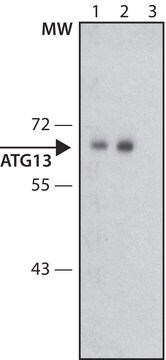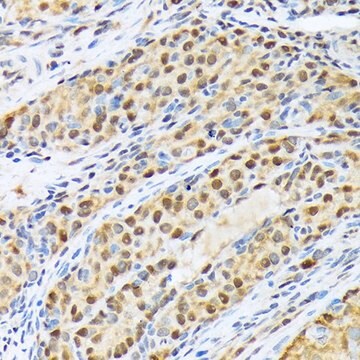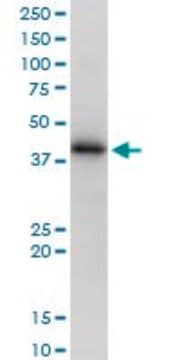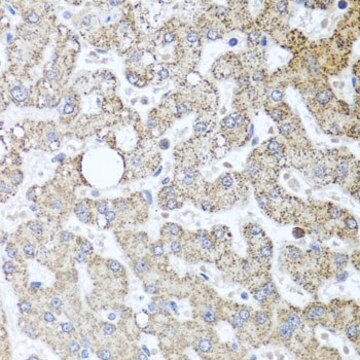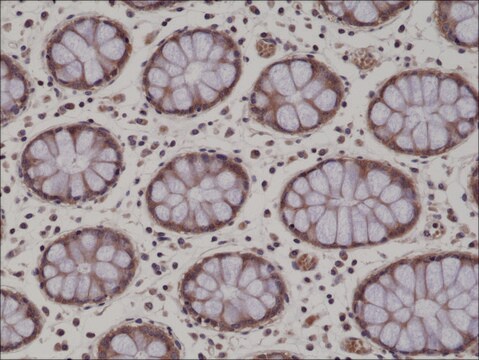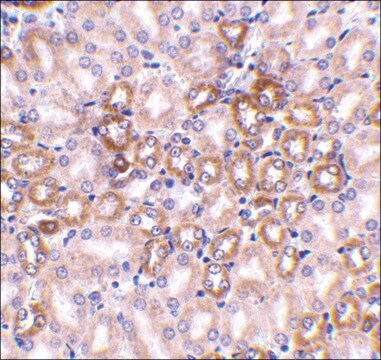推荐产品
生物源
rabbit
共軛
unconjugated
抗體表格
affinity isolated antibody
抗體產品種類
primary antibodies
無性繁殖
polyclonal
形狀
buffered aqueous solution
分子量
~30 kDa
物種活性
human
濃度
~1.0 mg/mL
技術
western blot: 0.25-0.5 μg/mL using whole extracts of HEK-293T cells over expressing human Atg101
運輸包裝
dry ice
儲存溫度
−20°C
目標翻譯後修改
unmodified
基因資訊
human ... C12orf44(60673)
一般說明
Autophagy101 (Atg101) is located on the human chromosome at 12q13.13.
應用
Anti-Atg101 antibody has been used in
- immunoblotting
- immunofluorescence
- immunopurification
生化/生理作用
Autophagy101 (Atg101) is a mammalian Autophagy13 (Atg13) binding protein essential for autophagy. Atg13 forms a stable complex with ULK1 (Serine/threonine-protein kinase ULK1) and FIP200 (FAK family kinase-interacting protein of 200 kDa). Atg101 associates with the ULK1-Atg13- FIP200 complex through direct interaction with Atg13. Mammalian target of rapamycin (mTOR) interacts with the ULK1-Atg13-FIP200 complex in a nutrient dependent manner, suggesting that mTOR regulates autophagy through this complex.
外觀
Solution in 0.01 M phosphate buffered saline, pH 7.4, containing 15 mM sodium azide
免責聲明
Unless otherwise stated in our catalog or other company documentation accompanying the product(s), our products are intended for research use only and are not to be used for any other purpose, which includes but is not limited to, unauthorized commercial uses, in vitro diagnostic uses, ex vivo or in vivo therapeutic uses or any type of consumption or application to humans or animals.
未找到合适的产品?
试试我们的产品选型工具.
儲存類別代碼
10 - Combustible liquids
閃點(°F)
Not applicable
閃點(°C)
Not applicable
Expression of a ULK1/2 binding-deficient ATG13 variant can partially restore autophagic activity in ATG13-deficient cells
Hieke N, et al.
Autophagy, 11(9), 1471-1483 (2015)
Molecular Machinery and Genetics of the Autophagy Pathway
Autophagy in health and disease, 16-16 (2012)
Mei Yang et al.
Science advances, 2(9), e1601167-e1601167 (2016-09-13)
The intronic GGGGCC hexanucleotide repeat expansion in chromosome 9 open reading frame 72 (C9ORF72) is a prevalent genetic abnormality identified in both frontotemporal dementia (FTD) and amyotrophic lateral sclerosis (ALS). Smith-Magenis syndrome chromosomal region candidate gene 8 (SMCR8) is a
Atg101, a novel mammalian autophagy protein interacting with Atg13
Hosokawa N, et al.
Autophagy, 5(7), 973-979 (2009)
Eleftherios Karanasios et al.
Nature communications, 7, 12420-12420 (2016-08-12)
Autophagosome formation requires sequential translocation of autophagy-specific proteins to membranes enriched in PI3P and connected to the ER. Preceding this, the earliest autophagy-specific structure forming de novo is a small punctum of the ULK1 complex. The provenance of this structure
我们的科学家团队拥有各种研究领域经验,包括生命科学、材料科学、化学合成、色谱、分析及许多其他领域.
联系技术服务部门